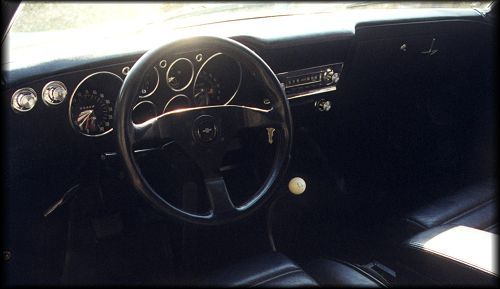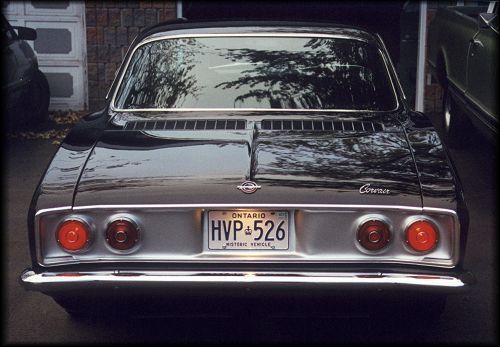

![]()
Dave Binnie's Blow-through Turbo
|
Crankcase and reciprocating assembly: A strong bottom end is a must for a turbo engine. Dave used a 1964-69 vintage block. He notes that the factory frequently used .001 main bearings on some journals to compensate for irregularities in the manufacturing process. He recommends holding out until you can find a block that will allow the use of standard bearings throughout, and he practiced what he preaches when he picked the block for the Monza. Dave cleaned the block halves thoroughly, removed casting flash and relieved the oil passages. He also used saddle studs as insurance against untimely separation of the block halves under the stress of full boost at high rpm. The crankshaft is a stock Tuftrided crank used by GM in both the 140 hp carbureted and 180 hp turbo engines. Oil holes are chamfered. Bearings are Clevite 77. The pistons are TRW forged flat tops, which in this application yield a compression ratio of 8.00:1. Rings are Hastings chrome. Piston/connecting rod assembly weights are equalized and the connecting rods are installed on the crank with clearances of .002-inches. The reciprocating assembly is balanced. Flywheel/Clutch: A Dale Manufacturing bolted flywheel and a factory clutch and pressure plate transfer power to the transaxle. Exhaust: The exhaust system consists of NOS GM pipes and a Walker DynoMax Turbo muffler. Performance: When I interviewed Dave, it was in Ottawa in the dead of winter, and the car was back in Toronto, so we couldn't take it out for a ride. However, as he described the sensation of jamming the turbo through the gears, his eyes lit up with a boyish enthusiasm. He told me about the "solid punch in 1st gear," the "quick, positive response of the shifter," and in the higher gears, how the "whine of the turbo" mixes with the characteristic heavy duty whine of the Saginaw transaxle, all punctuated by the burst of the by-pass valve unloading on every shift! When pressed for the hard facts on performance indicators like 0-60 mph or quarter-mile times, Dave is quick to point out he hasn't yet had a chance to generate official time slips. He will, however, volunteer that the turbo engine makes full boost (currently set to 10 lbs) through the gears and easily red lines in high gear. Based on the 3.55:1 final drive ratio and the circumference of the tires, it sounds like the ride to 110+ mph is a quick one. He won't say it, but I will: There'll be a few slack jaws at the drag strip when this puppy shows up. Fast Vairs member, Al Kidd, recently commented on the performance of Dave's Monza in a message posted to the group. "Dave just lives a half hour away from me." he said, " We autocross at the same place. He has an attention-to-detail and appearance that is second to none and his car is fast. At the last autocross he made it to, he was running with the 'vettes and within a couple of thousandths of me with only half boost. This is a setup worth looking at." |
|
Cockpit/Interior: No fuss, no muss. A transplanted Corsa instrument cluster features a 140 mph speedo, 6000 rpm tach, cylinder head temperature gauge and is retrofitted with an Auto Meter boost gauge. The smaller-than-stock diameter Momo steering wheel is tasteful, updates the cockpit to current standards, and quickens steering response. |
 |
|
The well bolstered leather seats are Porsche 911 items, and offer more lateral support that the stock seats. Dave credits his brother, Bill, for building the adapters needed to fit the Porsche seat frame rails to the floor pan. All weather stripping was replaced and the glass is in great condition. The rear seat area gets some use, too. Dave and his wife, Toni, have a couple of young children who like to ride along, from time to time. |
|
|
Personal touches: Dave refers to his Monza as a "mutt," a reference to his departure from stock '65 parts out of personal preference. At right, we see he attached a '66 Corsa turbo emblem to his deck lid, painted the rear cove area silver, and screwed on some '66 style tail light lenses. That's the beauty of either the early or late model Corvair. Each style was manufactured for 5 years, and many of the parts can be interchanged to suit the individual tastes of the owner. |
 |
|
People new to the Corvair hobby can have some fun discovering what is stock and what isn't for a given year. That brings to mind; Larry Claypool wrote a series of articles for CORSA called "Stock Is" It is an excellent resource available to all CORSA members. If you're not already a member, consider joining the Corvair Society of America. You'll find a link to the CORSA site in the Links section of this site. Don't go there yet, however. We've got some outstanding pictures next! |
Click the road sign for more.
Select from the navigation bar!